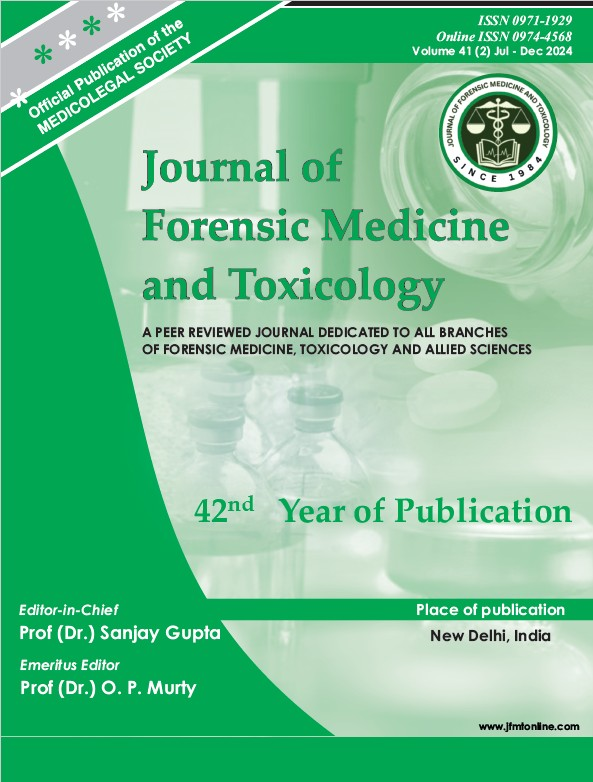RELIABILITY OF BITE MARK ANALYSIS AS A TOOL FOR FORENSIC INVESTIGATION
Keywords:
Bite mark, Photography, Metric measurement, Computer assisted Bite mark analysis, dentition scan method, Inter-observer variationsAbstract
Aim: 1. To determine the Feasibility of bite mark analysis in forensic investigation 2. To evaluate the Reliability of bite mark analysis 3. To evaluate the Acceptability of bite mark as evidence Materials and Methods: Photographs of Bite Marks of 50 consenting volunteers were taken. Impressions of Bite The findings showed that among the three methods The bite mark analysis has to be used for as This is followed by Computer Assisted Hand Tracing Overlay Technique which is Reliable but has to be used cautiously due to inter-observer bias. The Metric method has proved to be Unreliable, hence has to be avoided.
Downloads
References
Pramod KD, SV Srinivasan, Rajesh PP, Bite Mark Evidence, A textbook of Forensic Odontology, Paras Publications; 1998:69-78.
Pretty IA and Sweet D. A Paradigm shift in the analysis of bitemarks. Journal of Forensic Sciences International 201(2010): 38-44.
Hyzer WG, Krauss TC. The bitemark standard reference scale-ABFO No. 2. J Forensic Sci 1988; 33(2):498-506.
Sweet D, Pretty IA. A look at forensic dentistry Part 2: teeth as weapons of violence identification of bitemark perpetrators. Br Dent J. 2001~190:415–8.
Pretty IA and Sweet D. Anatomical location of bite marks and associated findings in 101 cases from the United states. Journal of Forensic Sciences 2000; 45(4):812-4.
Breath As. The Herman Beerman Lecture: Embroyology of Human Skin, a review of ultrastructural studies. Journal of investigative Dermatology 1971; 57(3):133-43.
C. Stavrianos, D. Tatsis, P. Stavrianou, A. Karamouzi, G. Mihail and D. Mihailidou. Intercanine distance as a recognition method of bite marks induced at cases of child abuse. Research Journal of biological Sciences. 2011; 6(1): 25-29.
Samir E. Bishara, Jane R. Jakobsen, Jean Treder, and Arthur Nowak. Arch width changes from 6 weeks to 45 years of age. Am J OrthodDentofacOrthop. 1997;111:401-9.
B Rai, J Kaur, S Dhattarwal, S Rathee, S Anand. Changing Maxillary and Mandibular Inter-canine and Inter-molar Distance between 8 to 20 years: Male and Female. The Internet Journal of Forensic Science. 2007 Volume 3Number 1.
Mohammad Akbar Khalil, Adil Jan, Abdullah, Tariq Aziz. Human’s Dentition Use in Criminal Investigations. Pakistan Oral and Dental Journal. 2004; 34(4): 743-747.
Shankar M Bakkannavar, Pratik V Tarvadi, Pavanchand Shetty, Raghavendra Babu YP, Vinod C Nayak, Pradeep Kumar G. Gender Differentiation using Inter-Canine Distances among South Indians. Journal of pharmaceutical and biomedical sciences (J Pharm Biomed Sci.) 2013 November 35(35):1860-1865.
M. Jonathan Daniel, Mihir Khatri, SV Srinivasan, VK Jimsha, Fremingston Marak. Comparison of Inter-Canine and Inter-Molar Width as an Aid in Gender Determination: A Preliminary Study. J Indian Acad Forensic Med. April-June 2014; 36(2):168-172.
Dr. Bindu Aggarwal, Dr. K Vasudeva, Dr. Subash Kaushal, Dr. Usha Chhabra, Dr. Sanjay Singla. Gender based comparison of intercanine distance of mandibular permanent canine in different populations. Journal of Punjab Academy of Forensic Medicine and Toxicology. 2008; 2.
Peeyush Shivhare, Lata Shankarnarayan, Sowbhagya Malligere Basavaraju, Ashish Gupta, Vinitra Vasan, and Usha Jambunath. Intercanine width as a tool in two dimensional reconstruction of face: An aid in forensic dentistry. Forensic Dent Sci. 2015 Jan-Apr~ 7(1): 1–7.
S. V. Tedeschi-Oliveira M. Trigueiro, R.N. Oliveira, R.F.H. Melani. Intercanine distance in the analysis of bitemarks: a comparison of human and domestic dog dental arches. J Forensic Odontostomatol 2011;29(1):30-36.
Nishant Singh, Neeraj Grover, Navin Puri, Sangeet Singh, Swati Arora. Age estimation from physiological changes of teeth. A Reliable age marker? Journal of forensic dental sciences. 2014;6(2):113-121.
Boaz K, Gupta C. Dimorphism in human maxillary and mandibular canines in establishment of gender. J Forensic Dent Sci.2009;1:42-4.
M. Yuwanati, A. Karia, M. Yuwanati. Canine tooth dimorphism: an adjunct for establishing sex identity.J Forensic Dent Sci.2012;4:80–83.
P. Bansal, S. Saxena, V. Reddy Mandibular canine index as a sex determinant: A study on the population of western Uttar Pradesh. J Oral Maxillofac Pathol.2008;12:56–59.
Ch. Saikiran, Tanya Khaitan, P. Ramaswamy, S. Sudhakar, B. Smitha, G. Uday. Role of mandibular canines in establishment of gender. Egyptian Journal of Forensic Sciences. September 2014;4(3):71–74.
Mihir Khatri, Mariappan Jonathan Daniel, and Subramanian Vasudevan Srinivasan. A comparative
study of overlay generation methods in bite mark analysis. J Forensic Dent Sci. 2013 Jan-Jun~ 5(1): 16– 21.
Sweet D, Bowers CM. Accuracy of bite mark overlays. A comparison of five common methods to produce exemplars from a suspect’s dentition. J Forensic Sci. 1998; 43: 362-7.
Maloth S, Ganapathy K S. Comparison between five commonly used two dimensional methods of human bite mark overlay production from the dental study casts. Indian J Dent Res 2011~22:493.
David Sweet, Robert E Wood. Computer – Based Production of Bite Mark Comparison Overlays. J Forensic Sci. 1998. 43(5): 1050-1055.
Rathore P, Sood S. Image Perception Technology a New Horizon: A Comparative Study on Bite Mark Analysis. Arch of Dent and Med Res 2015;1(3):9-14.
M. Jonathan Daniel, Mihir Khatri, SV Srinivasan, VK Jimsha,Fremingston Marak. Comparison of Inter Canine and Inter-Molar Width as an Aid in Gender Determination: A Preliminary Study. J Indian Acad Forensic Med. April-June 2014; 36(2):168-172.
Shankargouda Patil, Roopa S Rao, Thirumal Raj. A comparison between manual and computerized bite mark analysis. Journal of Advanced oral research 2013;4(3):1-6.




